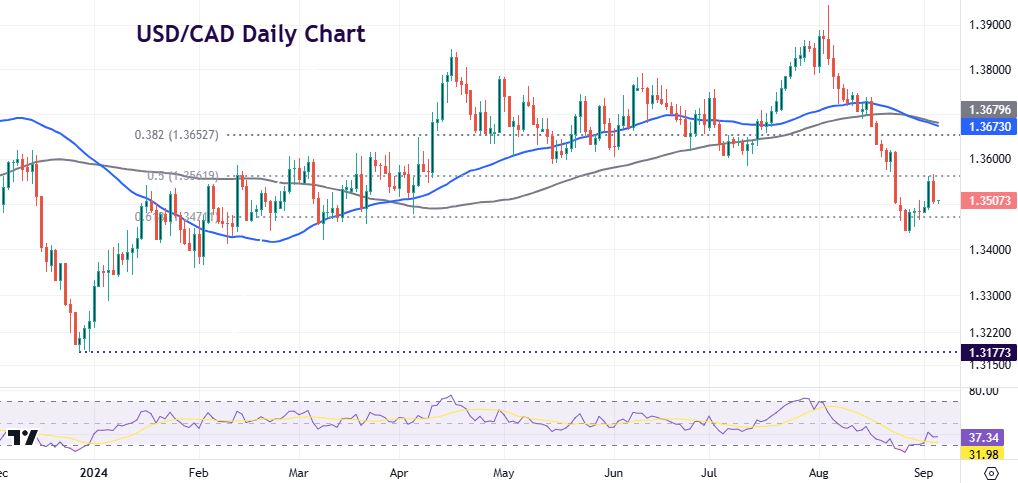Dollar turns lower while oil hits nine-month lows

Headlines
* CAD gains as market takes BoC rate cut and future easing in its stride
* Dollar drops as weak jobs data fuels Fed rate cut bets
* Wall Street ends marginally lower after dovish Fed comments and soft data
* Brent crude extends losses to December lows, OPEC+ consider delaying output increase
FX: USD fell back into the descending channel after softer jobs data. The JOLTs job openings declined more than expected to a three and a half year low and below the bottom of the forecast range. The quits rate moved higher which is a good lead indicator and dovish. A Fed official also said rate setters can’t afford to wait for inflation to hit 2% before reducing rates. Chances of a 50bps move improved to 45% from near 30% at the start of the week.
EUR ticked up as support at 1.1062 did a job. Final Eurozone Services and Composite PMI data were a little worse than the preliminary August prints.
GBP also ticked higher as cable found support just above 1.31. UK final August Services and Composite PMI data were revised modestly higher to 53.7 and 53.8.
USD/JPY saw aggressive selling for a second straight day with prices nearing initial support at 143.44. After this level only lies the spike low from early August at 141.68. Struggling equities have favoured safe haven currencies, with the yen strongly outperforming so far this week.
AUD steadied, though still underperformed, as Q2 GDP came in at 0.2% missing the estimate and reflecting higher government spending. Without the fiscal boost, growth would have been negative. USD/CAD gave back most of yesterday’s losses. The BoC cut rates as expected but didn’t hint at faster easing.
US Stocks: Stocks gave back more ground with losses widespread but not to the same extent Tuesday’s sell-off. The S&P 500 lost 0.16% to settle at 5,520. The tech-laden Nasdaq 100 fell 0.20% to finish at 18,921. The Dow closed 0.09% higher to close at 40,974. Energy, tech and materials struggled. Nvidia saw more weakness after reports of a DoJ subpoena were denied by the giant chipmaker. The megacap lost a mammoth $279 billion off its market cap on Tuesday. The Semiconductor index (SOX) rebounded from its biggest one-day drop Tuesday, since the pandemic.
Asian stocks: Futures are lower. Asian stocks traded in the red after the grim session Stateside. Chips stocks led the selling. The ASX 200 dropped on tech and miners with heavyweight healthcare helping. The Nikkei 225 got hit by the stronger yen and the tank in tech. The index fell close to 37,000. The Hang Seng and Shanghai Composite were both down the oil names in the former getting sold aggressively.
Gold slid to a 10-day low at $2471 before the softer dollar and yields saw buying. Prices closed above the mid-July top at $2483. Brent crude made fresh year-to-date lows with levels last seen in mid-December. Future demand concerns on increasing supply and a possible Libyan government deal are impacting.
Day Ahead –US ISM Services
Consensus forecast a meagre increase to 51.5 in August from 51.4 in July. As a guide, the S&P Global’s flash PMI data saw rose to a two-month high of 55.2. Data painted a solid growth picture and robust Q3 GDP growth allaying fears of a near-term recession. A fall in selling price inflation to a level close to the pre-pandemic average was also encouraging.
But growth has become increasingly dependent on the service sector as manufacturing, which often leads the economic cycle, has fallen into decline. However, service sector growth was being constrained by hiring difficulties, which continue to push up pay rates. Prices paid will be a focus too.
Chart of the Day – USD/CAD taps 50% retrace and falls back
Markets breathed a small sigh of relief for the loonie after the BoC meeting and press conference. Traders priced out risks of bigger 50bps cuts before year-end. Certainly, more easing is coming in October and December with weak growth rising unemployment and slowing inflation. But the USD leg is now more important. Governor Macklem said he believes concern over rate-policy divergence from the Fed should now be put to rest.
A push above 1.3561 resistance (50% retracement of this year’s high to low) could have allowed the USD to appreciate a little more to 1.3652 (38.2% retracement) and potentially towards the mid/upper 1.36s. Support is 1.3471 and 1.3436/42.

The information has been prepared as of the date published and is subject to change thereafter. The information is provided for educational purposes only and doesn't take into account your personal objectives, financial circumstances, or needs. It does not constitute investment advice. We encourage you to seek independent advice if necessary. The information has not been prepared in accordance with legal requirements designed to promote the independence of investment research. No representation or warranty is given as to the accuracy or completeness of any information contained within. This material may contain historical or past performance figures and should not be relied on. Furthermore estimates, forward-looking statements, and forecasts cannot be guaranteed. The information on this site and the products and services offered are not intended for distribution to any person in any country or jurisdiction where such distribution or use would be contrary to local law or regulation.
